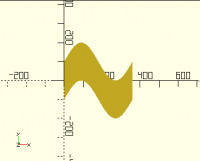
Re: Create [x,y] - 2D values from a formula to a polygon
There are any number of ways to put together a 2D figure, but you've
found the right basic approach for the general case.
On 3/26/2022 3:40 PM, Jan Öhman via Discuss wrote:
I found a tip (but I do not understand what happens and how to use it
in my case.)
radius = 10;
fn = 18; // The shape
v1 = circv(radius, fn);
dispv(v1);
// create 2d vector shape: circle
function circv(r=1, fn=32) =
[ for(i=[0 : fn-1]) [rcos(360i/fn),rsin(360i/fn)] ];
// display a 2d vector shape
module dispv(v){
indi = [[for(i=[0 : len(v)-1])i]];
polygon(points=v, paths=indi);
}
This is more complex than is needed.
Here's a simpler version of the same thing:
radius = 10;
fn = 18; // The shape
v1 = circv(radius, fn);
polygon(v1);
// create 2d vector shape: circle
function circv(r=1, fn=32) =
[ for(i=[0 : fn-1]) [r*cos(360*i/fn),r*sin(360*i/fn)] ];
There are three interesting parts of this program:
-
Drawing a polygon. Given a list of points, OpenSCAD will draw a
polygon. But how do you easily make a list of points from a formula? -
List comprehension. When you say something like
list = [ for (i=[1:10]) i*i ];
echo(list);it builds a list by repeatedly evaluating the expression. Try
running that little program.There are several other variations on list comprehensions and they
are useful in a wide variety of cases, but that's the basic one that
you need for generating lists of points. But what are the right
values of the points? -
Equation of a circle. There are many ways to formulate the points
for a circle. Here the author is trying to generate an n-sided
polygon. They have i step from zero to one less than the number of
vertices, and for each one they calculate an angle that splits the
circle evenly - 360i/fn. Call that angle a. The point [ rcos(a),
r*sin(a) ] is one point on that circle.
Net, they're calculating successive points on a circle, putting them all
in a list, and calling polygon() on the result.
The general pattern is
start = ... whatever start value ...;
end = ... whatever end value ...;
step = ... whatever step ...;
function f(i) = ... whatever generates your points, given i ...;
points = [
for (i=[start:step:end]) f(i)
];
polygon(points);
So, for instance, this will generate a one-unit-radius circle (with far
more sides than it needs):
start = 0;
end = 360;
step = 1;
function f(i) = [ cos(i), sin(i) ];
points = [
for (i=[start:step:end]) f(i)
];
polygon(points);
Here's another example that is slightly more complex, adding a couple of
fixed points:
points = [
[0,0],
for (i=[0:10]) [ i, i*i/10 + 1 ],
[10, 0]
];
polygon(points);
Note that you don't need to write the formula in the form of a
function - do it if it makes it easier for you to understand.
You can get arbitrarily more complex - for instance:
points = [
for (x=[0:360]) [ x, sin(x)*100+100 ],
for (x=[360:-1:0]) [ x, sin(x)*100-100 ],
];
polygon(points);



